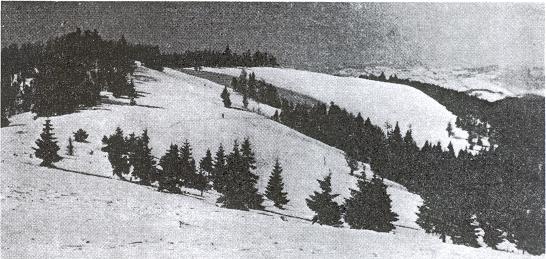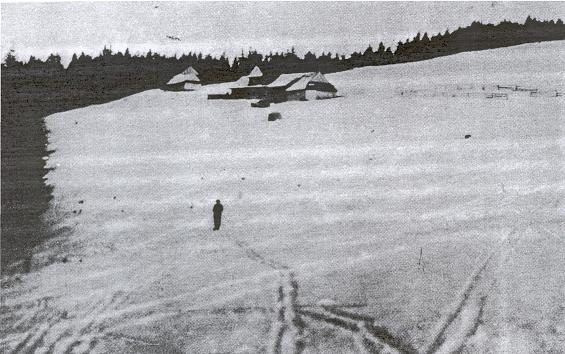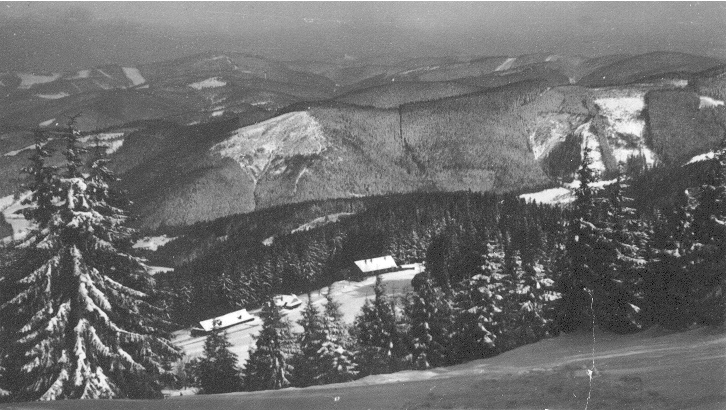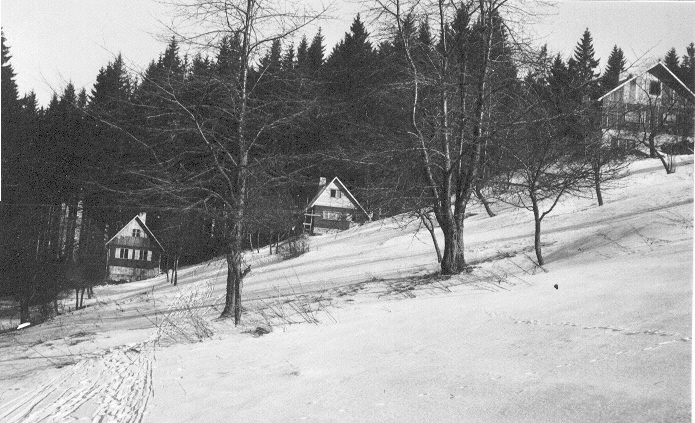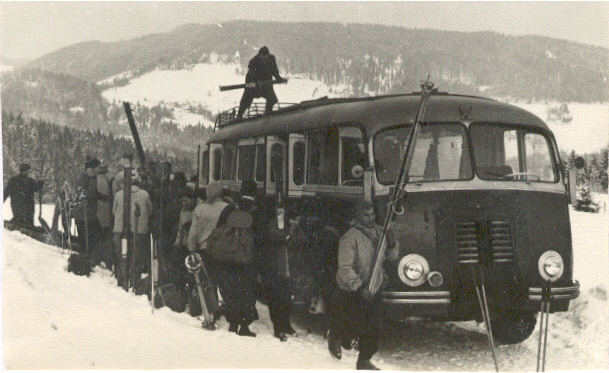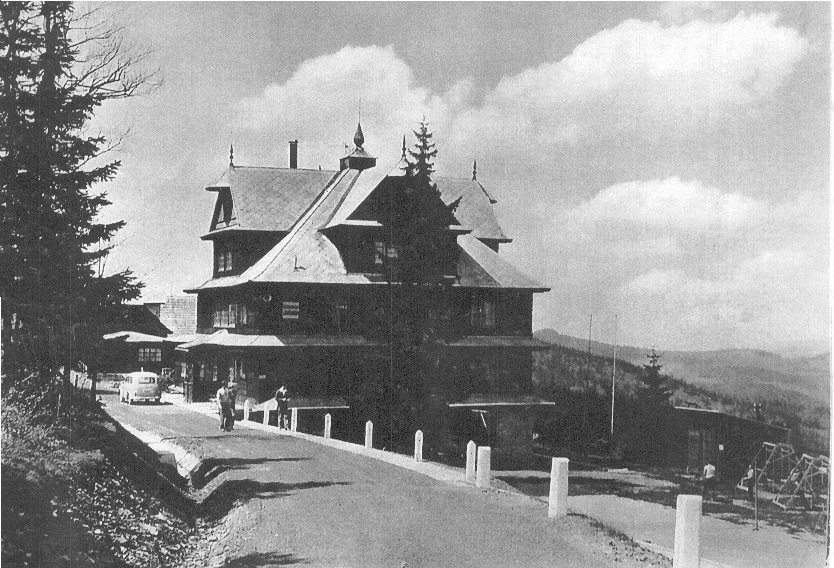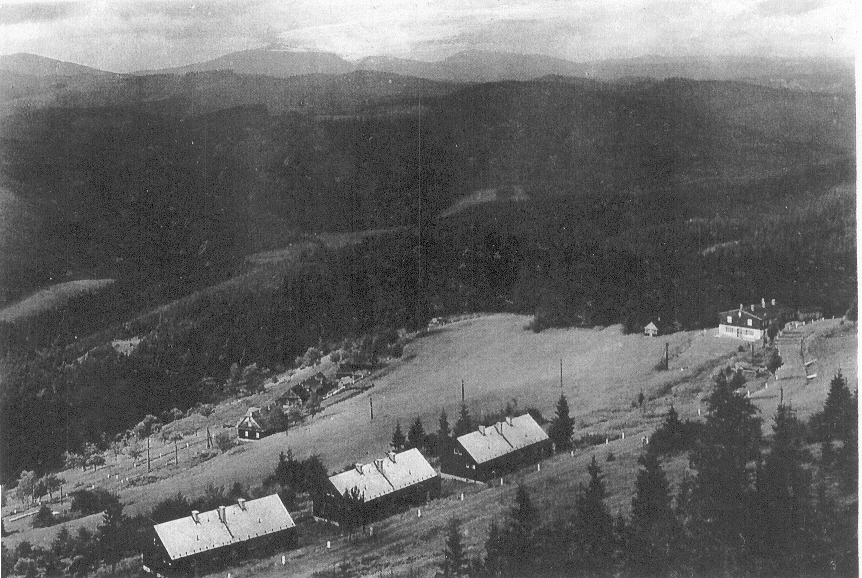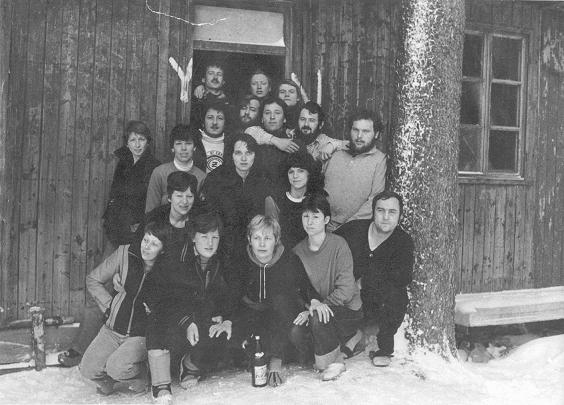The Beginnings of Skiing in the Zlín Region
The History Begins in Lukov
When the oldest ski association, the Czech Ski Club in Prague, published a richly illustrated book in 1927 to mark the 40th anniversary of skiing being introduced to Bohemia, two major skiing regions—Krkonoše and Šumava—competed for the title of skiing pioneer. Ultimately, representatives of both regions had to acknowledge that the first organized ski races in Czechoslovakia took place in Lukov, in the Zlín region, as early as February 1893. These were properly organized events with a significant turnout, and the winner, Bohumír Schőber, a forester from the Lukov estate, was awarded a gold watch.
Alois Chytil, a witness to these races, member of the Ski Union, and editor of the aforementioned publication, added that ski races were held in Lukov in subsequent years as well, including in 1895, when they were organized for schoolchildren.
How did this unique skiing achievement come about? It is well known that Count Jan Harrach first introduced skis to Bohemia in the winter of 1892–1893 for the foresters on his estate. However, it is less well known that, during the same winter, Count Seilern, the owner of the Lukov estate, also provided skis to all foresters on his extensive estate. Whether this was a coincidence or whether both Harrach and Seilern were working together to introduce skiing is irrelevant. What matters is that Lukov holds an honorable place in the history of Czech skiing, and it is up to us to ensure that this pioneering period is not forgotten.
The Founding of the Ski Club and Its Early Years
After the Lukov episode, the Zlín region waited a long time for the revival of skiing, until 1926. During this period, milder winters meant little snow in the foothills of the Hostýn Hills, leading foresters and loggers to set aside their skis, which eventually became a rarity in the area.
The mid-1920s was a time of growth for various sports clubs that later formed the Physical Education Unit Gottwaldov. Most of these clubs were active from spring to autumn, but what about winter? In search of an answer, a group of 40 skiing enthusiasts, with the help of a local magazine, gathered on November 8, 1926, for an inaugural meeting and founded the "Winter Sports Department." Since skaters and sledders showed no interest in participating, the department was named the "Skiing Section."
The first elected leaders of the department included Josef Vaňhara, Karel Bára, Jan Kocmich, Jan Kočenda, Dr. Vl. Mazal, Marie Havránková, and Josef Kovařík, who continued to lead the group in the following years.
With enthusiasm and determination, the first skiers got to work. However, they faced challenges with trainers, skiing techniques, and equipment. Although skis had occasionally been manufactured in the small woodworking factory in nearby Fryšták since the Lukov days, knowledge of skiing techniques, such as telemark and the original Christiania turn, was limited to those from the Krkonoše region. Modern downhill skiing techniques arrived in Bohemia and Moravia much later.
First Competitions and the Search for a Skiing Center
During the first two winters after the club's founding, Zlín skiers traveled to Hostýn for snow, where suitable meadows allowed for practice. The first club ski races were held on February 20, 1927, in Hutisko near Rožnov, with support from the local school principal and a well-known skiing advocate.
The races included 20 men and 5 women from the club, several guests, and dozens of local boys from Hutisko. The winner was Bohumil Kupec, the manager of the Zlín hospital.
At Christmas in 1927, a group of Zlín skiers visited the Bílý Kříž area in the Beskydy Mountains. There, they realized the need for their own skiing center with suitable terrain, as the Hostýn area was also frequented by skiers from Kroměříž, Prostějov, and Hranice. The slopes were overcrowded, and even the dining areas were insufficient for everyone.
On their way back from Bílý Kříž, they traveled towards Třeštík and across Benešky to Velké Karlovice. In Benešky, on a frosty morning, they saw the snow-covered, treeless ridge of the Javorníky Mountains, and the future of skiing in the Javorníky was decided.
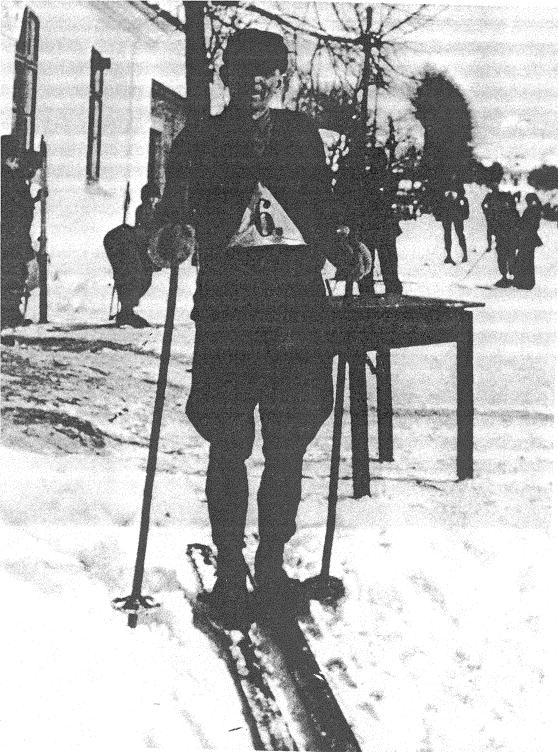
Bohumil Kupec, the hospital manager, winner of the first club ski race in Hutisko on February 20, 1927.
Zlín Region and the Javorníky Mountains
In the second half of the 1920s, the Javorníky Mountains were still a pristine land. Throughout the 26 km long mountain range, there were a few herds of sheep and cattle, which remained in the area from spring to autumn. During the summer, the occasional tourist would pass through, but neither foresters nor residents of the mountain cabins ventured across the ridges.
In the spring of 1928, after exploratory trips to Nový Hrozenkov and Velké Karlovice, members of the skiing club discovered that two locations were suitable for establishing a base in the Javorníky Mountains. These were Společný with Kohútkou, accessible from Nový Hrozenkov through the Vranče valley, and Velký Javorník with Kasárna, accessible through the Podťaté valley from Velké Karlovice.
The decision was not easy, but in the end, Kasárna was given priority, as it was the only place with a log cabin with an attic, which had served as the home of a shepherd and his family, as well as a log annex that was used as a storage for feed. After negotiations with the forestry administration, which owned the entire building, an agreement was reached to rent the log annex and convert it into a ski lodge.
Then, over the summer, with the support of skiing enthusiasts from Karlovice, the cabin was repaired, furniture was ordered for the common room, beds, bedding, blankets for two shared bedrooms, dishes, and other kitchen equipment for forty members of the club. The money for the interior furnishings of the cabin, which at the time cost 22 thousand crowns, was raised by 18 club members who contributed a thousand crowns each, while the remaining four thousand were provided by wealthier supporters of the sports club. In the last days of October 1928, this first ski lodge in the Javorníky was opened and became a weekly destination both in winter and summer.
This first mountain shelter on the ridge of the Javorníky, along with the regular trips of Zlín's skiers to this pristine nature, caused previously unforeseen consequences.
Right after the winter season in 1929, the district governor of Vsetín and the baker from Karlovice, Kobliha, visited the secretary of the Zlín Ski Club to discuss their plan. The Karlovice baker Kobliha was prepared to build a hotel at the end of the Podťaté Valley, and the district office promised to repair the bad road so that buses and cars could reach the forest lodge under Velký Javorník.
However, they wanted an assurance that the Zlín skiers would use this projected hospitality. And so, from that time on, there was a hotel at the end of the Podťaté Valley called "U Polanských," which was visited annually by dozens and hundreds of skiers and tourists.
In the first two winters after the opening of the cabin, the Zlín Ski Club members were alone at "Kasárna," but as the interest in skiing grew, in 1930, a military unit from Valašské Meziříčí first built log barracks and eventually an entire recreational center for their troops. In addition to the soldiers, interest from civilians also grew, and within five years, the number of skiers visiting Velký Javorník rose to hundreds, and the area could now be compared to the busiest regions of the Beskids. The accommodation capacity of the cabin was no longer sufficient, so there were discussions about building a mountain hotel. However, this project was abandoned because the building would also require a road to the hotel, which would more than double the construction cost.
Thus, the ski club resumed contacts with the Club of Czech Tourists in Nový Hrozenkov, and especially with Professor František Hlavica from Brno Technical University, who had purchased part of Kohútka from the owner of the Čertov estate with the intention of building a cabin there.
Before that, the original plan was realized: the construction of a hotel under Stolečný, and the people of Hrozenkov were already opening the Portáš Hotel ceremoniously in the fall of 1930. When, two years later, the Club of Czech Tourists from Karlovice built another mountain cabin at Kasárna, the original plan for the development of skiing and tourism in the Javorníky Mountains was fulfilled.
Years of Sports Growth
After a detailed introduction to the initiative and organizational efforts of the club, let's now focus on the actual sporting and competitive activities in the early years of the ski club's establishment.
However, it is important to note that skiing at that time had a completely different character than it does today. Training took place on the slopes of Velký Javorník or in the saddle of Butorky, as well as directly on Podťaté. Skiers learned the snowplow, telemark turns, or Christian turns, climbing, and descending. Alpine skiing, in its modern form, was not even imagined back then, nor were the Alps themselves. The main activity was ski tourism with many kilometers of hiking through the mountain winter landscape and ridge tours.
From Kasárna to Stolečný, ski tours were common for skiers, and the tracks were renewed week by week.
With the development of skiing came competitive sports, and from 1929, Zlín skiers participated in various ski races, already achieving good results. The titles of the Beskydy District champions moved to the club and were also successfully defended in the following years.
Some of the club's most successful skiers at that time included Jaroslav Kovařík, František Zelinka, Miroslav Hruška, Otakar Šuba, Rudolf Šícha, and a few years later, Alois Štěpán and Břetislav Šrubař. They competed with very good results in races throughout Moravia, and Břetislav Šrubař finished in 6th place at the National Championship and 20th at the European Championship in the combined event, which was considered a world-class result at the time.
This first successful racing era of the club lasted until approximately the mid-1930s. Then came a decline in the club's racing performance, and when the club was about to celebrate its 10th anniversary, both its racing and organizational activities were in decline. The first-tier competitors were leaving the activity, and the replacements were still growing, so only Břetislav Šrubař remained at a high level.
With the decline in racing activity came the overall decline of the club and its board. This was during the period of the Munich Agreement, the occupation, and the beginning of World War II. During this time, the best skiers were still Břetislav Šrubař, along with Jaroslav Pozníček, Miroslav Kosáček, and from the women, Reichlová-Hlaváčová, as well as the young skiers, the Vojtek brothers, Stříželka, Hartig, and others.
The Rise of Skiing in the Club of Czech Tourists
During the pre-Munich period, after the decline of the ski club, the initiative, leadership, and organization of skiing in Zlín were taken over by the tourist-ski club of the Club of Czech Tourists, which was established in the same year as the ski club, 1926.
This tourist-ski club was very active, organizing winter and summer trips, and groups of ski tourists were not limited to trips to the mountains, but also regularly met every week for meetings, where they watched films with skiing themes, organized lectures on ski theory, and later, as separate sections, they joined the Czech Ski Association.
After the establishment of the Slovak State in March 1939, the trips to the Javorníky Mountains stopped, as the area was occupied by the Germans, and for the next six years, skiers were left with only the nearby hills, and once again, places like Tesák, Hostýn, and the Vizovice Hills came into prominence. It was primarily Drdol on the Lipské pastures, 453 meters high, that replaced the lost terrains in the Javorníky for city skiers, supporting them during the difficult times of occupation and contributing to the further progress of skiing.
During this period, two young engineers, Eduard Černý and Zdeněk Kučera, both excellent skiers and, in the case of Černý, a recent graduate of alpine skiing training in the French Alps, arrived in the city. Both joined the club and soon became key members who influenced its activities. Thanks to them, occasional training sessions became regular alpine ski training based on the reverse Christian turn. As interest in this school and lessons grew, the instructional staff was expanded over the years with new members, including Fr. Podvala, Karel Bergman, Jaromír Pozníček, Jindřich Dobrovský, Evžen Reichel, Václav Kapic, and J. Komenda.
In these post-war years, rich in snow, it became a tradition for 200 or more skiers from Zlín to take the train to Lípa station every week and head together to Drdol for their regular training and snow exercises.
Skiers in DSO in Tatran – Later Center of Velký Javorník
The ski sections in the Workers' Sports Organizations of Spartak and Jiskra had already stabilized and began programmatically developing their activities when, in the fall of 1953, another section, this time from the Physical Education Union Tatran, joined them. DSO Tatran brought together athletes from the third large group of Gottwaldov workers, primarily builders from the national enterprise Pozemní stavby. The Tatranská section of Gottwaldov skiers settled permanently on Velký Javorník, returning to the places where organized skiing had started a quarter of a century earlier.
As in other sections, skiing in Tatran began to shift from recreational-touristic skiing toward alpine skiing, and as competitive aspirations grew, the members of the section built a small rope lift at Podťaté near the cabin they had built by their own efforts in 1956.
In the first five years, when the section was organizing itself, its activities were led by the board, initially with the leader Arnošt Večeřa and organizational worker Adolf Hruban. Later, A. Večeřa was replaced by Josef Grund in his position. In 1958, Ludvík Rajnoha and organizational worker Jan Dula took over the leadership. In September of this year, the unified Physical Education Union of Gottwaldov was established, and the ski section of Tatran joined it.
In the following paragraphs, we skip ahead in the chronology of this work, as the members of Tatran had somewhat different standing in the new conditions. Their skiing home was Velký Javorník, significantly distant from Portáš and Kohútka, the center of the joint section. In the year of the merger, an agreement was made between the skiers and Pozemní stavby to build a mountain cabin on Velký Javorník, which would be used by the skiers in winter and for recreation by Pozemní stavby employees in the summer. Therefore, the ski section was designated as the Velký Javorník center. While the joint section focused on the development of Portáš, the Velký Javorník skiers worked just as hard to develop this area.
The cabin on Velký Javorník began construction in 1958 and was completed in 1960. The skiers worked 8,000 volunteer hours on it. In the year the cabin was completed, a 550-meter ski lift was also built on the modified slope, meaning that the center now had a well-equipped base.
Meanwhile, the sports activities continued with equal enthusiasm. The center organized, for example, the district championship in cross-country skiing and became the founder of the youth competition "O stříbrnou vločku" (For the Silver Snowflake) in alpine skiing. The first "Silver Snowflake" race took place in 1962, and the fifth edition was already held as a regional control race for children, with participants being holders of Spartakiad snowflakes. Over time, the Silver Snowflake became a nationwide competition for children in alpine skiing.
The organizational tasks in the section were handled by a small group of experienced workers from the board, who remained in their positions year after year and formed its core.
The task of the section was primarily to organize skiing races for children and adults, train ski instructors, organize skiing holidays, and actively participate in training programs.
